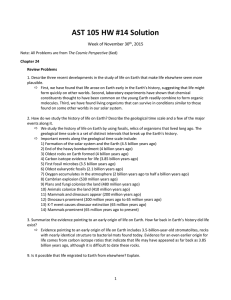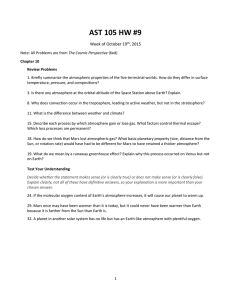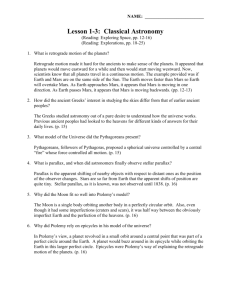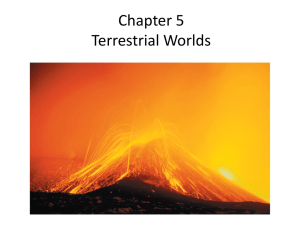Mars: Once A Habitable World? Nick Schneider
advertisement
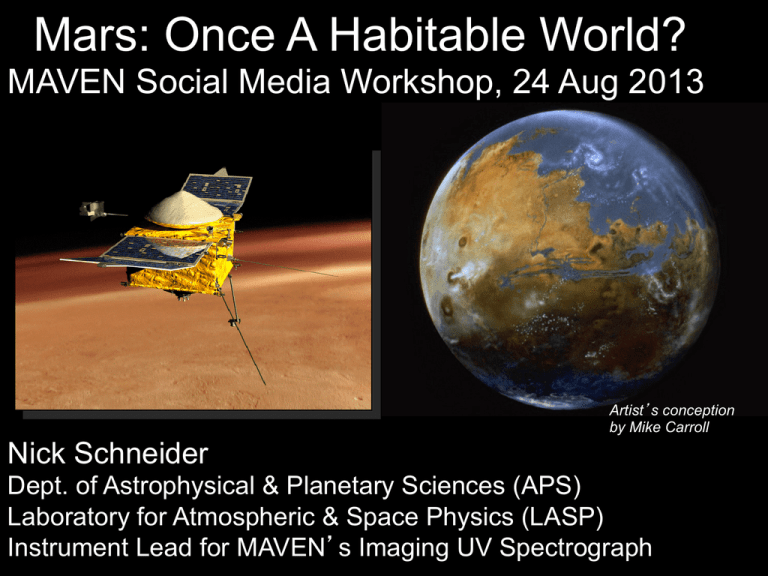
Mars: Once A Habitable World? MAVEN Social Media Workshop, 24 Aug 2013 Artist’s conception by Mike Carroll Nick Schneider Dept. of Astrophysical & Planetary Sciences (APS) Laboratory for Atmospheric & Space Physics (LASP) Instrument Lead for MAVEN’s Imaging UV Spectrograph Mars: Once a Habitable Planet? • What makes planets habitable? • What’s the evidence for Mars’ past habitability? • What made Mars habitable? What changed, and how? Discussion: What are the requirements for a Habitable Planet? • • • Energy source Chemicals (nutrients) Liquid water • Smaller worlds cool off faster and “harden” earlier • Larger worlds stay warmer inside, leading to more volcanism and tectonics • Larger worlds CAN have more erosion because they can create and hold an atmosphere • Planets closer to the Sun are too hot for rain, snow or ice, so have little erosion • Close planets are hotter, so they don’t retain their atmospheres as well • Planets far from the sun are too cold for rain, limiting erosion • Planets with liquid water have the most erosion • Planets with slow rotation have less weather and less erosion, and (we think) weaker magnetic fields • Planets with fast rotation CAN have more weather and more erosion, and stronger magnetic fields Decoding Planetary Images: The Four Basic Geological Processes • Impact cratering • Volcanism • Tectonics • Erosion Mars Today A Different Mars 11 What do rocks tell us about habitability? Artist’s conception by Mike Carroll Four Major Factors which affect Long-term Climate Change What could have sustained an early wetter environment? • Greenhouse warming required to raise temperature from current ambient surface temperature average of ~220K. – Degree of greenhouse warming required unclear, since ambient temperature during warmer epoch is uncertain. • Problem exacerbated by faint young Sun problem – Sun ~30% dimmer in total output 4 b.y. ago. • Possible greenhouse agents Kasting, 1991 – CO2 and H2O? – CH4, NH3? – Organic haze protectant? If Mars had a thick atmosphere, where it is now? If Mars had an ocean, where is all the water now? • Frozen at the poles? • Not enough! • Locked underground? • Not nearly enough! What other possibilities are left? Artist’s conception by Mike Carroll 3 Sources of Atmospheric Gas • TP’s too small to capture much gas from the Solar nebula. • Sources of atmospheric gas: • outgassing – release of gas trapped in interior rock by volcanism • evaporation/sublimation –liquids or ices turn to gas when heated • bombardment or “surface ejection”– micrometeorites, Solar wind, or high-energy photons blast atoms/molecules out of surface rock • occurs only if the planet has no substantial atmosphere already Volcanism: More than making mountains…. • Volcanism also releases gases from Earth’s interior into atmosphere • Outgassing:The origin of TP atmospheres! Outgassing Important for large terrestrial planets’s (warm interior --> volcanoes) Outgassing releases: 1. 2. 3. 4. Lots of H2O, Some CO2, A little N2, A hint of sulfur-bearing gases Where Did the Atmosphere Go? Up Down Loss Processes of Atmospheric Gas 4 Ways to lose atmospheric gas: • • • • condensation – gas turns into liquids/ices on the surface when cooled chemical reactions – gas is bound into surface rocks or liquids SW stripping – gas knocked out of the exosphere by Solar wind thermal escape – lightweight atoms lost to space when they achieve escape velocity v esc = 2GM R Thermal Escape Applet – Building Intuition Thermal Escape Easiest for: • Small worlds • Hot worlds • Light gases The End of the World – for Martians? Earth Mars


